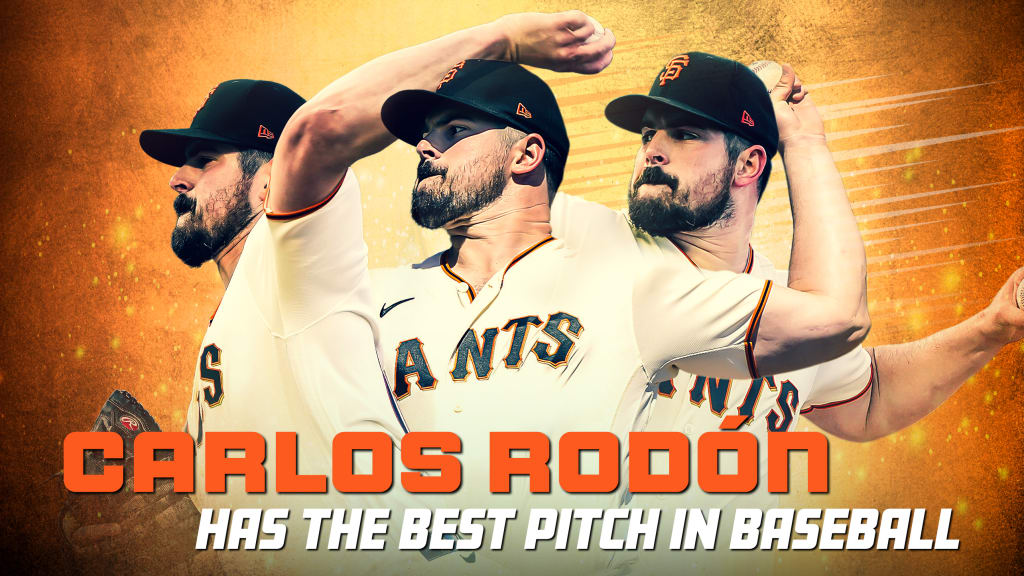
The best pitch in baseball can be found in San Francisco, just south of the Bay Bridge, making batters wish they’d never bothered to get on the plane. The best pitch in baseball is a fastball, notable in itself since we’re in Year 15 of the pitch tracking era, and for the first time, four-seam and sinking fastballs represent less than half of pitches thrown.
The best pitch in baseball, by some data and other acclaim, is Carlos Rodón’s four-seam fastball, the one that’s helped him get off to a 1.80 ERA start for San Francisco along with some borderline historic strikeout/home run numbers. He's one of just four pitchers to get through his first six starts with at least 53 whiffs and no dingers. We assume you've heard of Zack Greinke and Pedro Martinez, even if you don't know Rube Waddell.
“The quality of that fastball is exactly what we should be talking about,” Giants manager Gabe Kapler said.
OK, then. Let’s talk about it.
The best pitch in baseball has to have both quantity and quality. It has to be thrown well, but it has to be thrown often, too.
There’s also the fact that there’s a whole lot more to pitching than just what happens on the final pitch of the plate appearance i.e., “he’s allowing a .200 average on his slider.” When a pitcher gets ahead 0-2 on his fastball, then allows a hit on his slider -- as Rodón did against José Iglesias on Monday -- the value in those fastballs getting ahead 0-2 shouldn’t be discarded.
For that, we turn to run values, which assign value to every pitch, then aggregate them into a season ranking. The No. 1 pitch in baseball, of any type, in 2021, was Rodón’s four-seam fastball, which was judged to have saved 26 runs by itself. (It edged out Kevin Gausman’s splitter, which saved 23 runs.) The No. 1 pitch in baseball, of any type, in 2022, goes back and forth between Rodón’s four-seamer, or Justin Verlander's, or -- most improbably -- Chad Kuhl's slider, depending on who’s pitched most recently.
Put that together into a 2021-’22 leaderboard, and you get this:
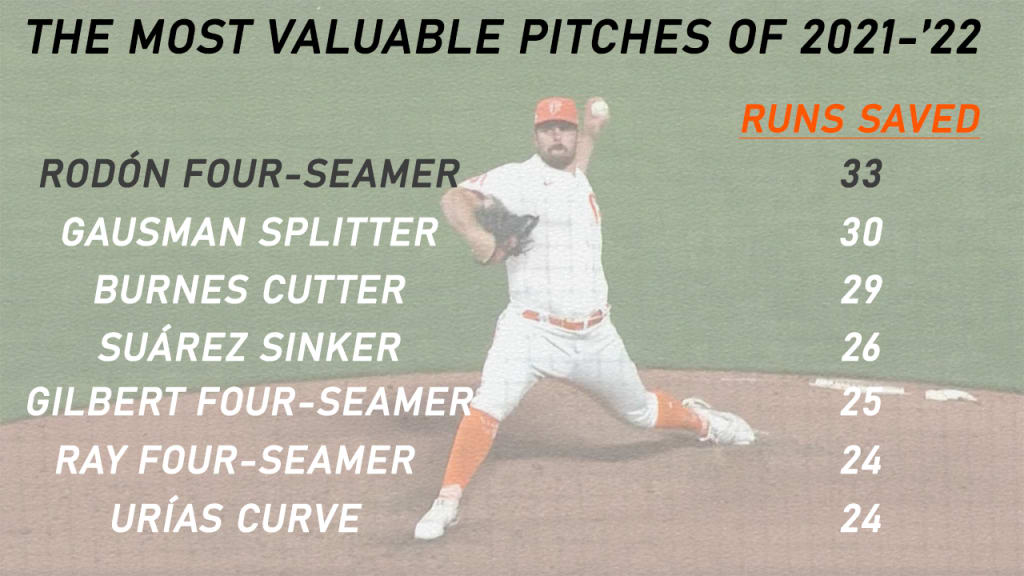
That’s the result of 1,677 Rodón fastballs in 2021-'22, which have allowed just 68 hits, but have collected 124 strikeouts. Of all those fastballs, 968 of them, or 58%, have gone for a strike, whether called, swinging or fouled. It’s the third-highest rate of any regular starter.
On a rate basis, there are better. You could point to, say, Ryan Helsley having yet to allow a hit on his fastball this season. Helsley, however, has thrown 72 four-seamers this season. Rodón has thrown 375. Quality matters, but so does quantity.
But what makes it so good, in a sport where pitches that move are all the rage? It wasn’t always this way; through 2019, it was actually a below-average pitch for him.
“It’s a unique fastball,” Kapler said. “We haven’t seen many like it over the last couple of years.”
Assistant pitching coach J.P. Martinez helpfully broke it down further, so we’ll do the same.
1. “I think, first of all,” Martinez said, “the velocity.”
Check. Rodón’s four-seamer averages 96.3 mph, which is the third-hardest of any left-handed starter this year. It’s a career high for him, up from last year’s 95.4 mph, which was up from 2020’s 92.8 mph and 2019’s mere 91.4 mph. That, right there, explains a lot of why it's working better now than it used to.
(There’s more than a little bit of a health factor here; Rodón underwent Tommy John surgery in 2019 and has had recurring shoulder issues for years, including missing much of last year's second half with Chicago.)
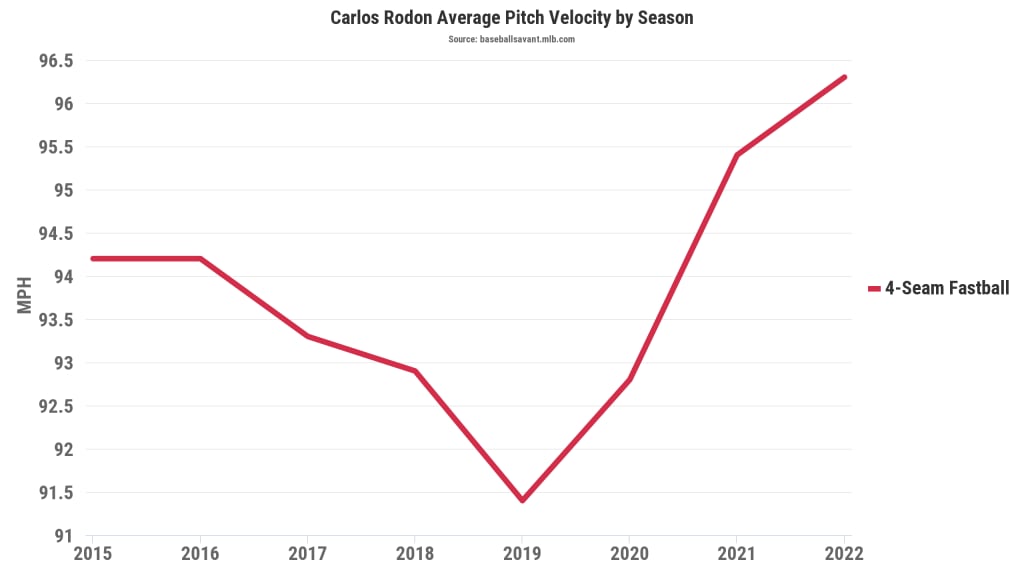
You can see it, too, in how often he tops 95 mph. As a rookie in 2015, about one-third of his four-seamers were 95 mph or more. In 2019, before he got hurt, only 2% of them were. This year? 87%.
2. “Second of all,” Martinez continued, “the vertical break.”
Check. In four-seam terms, you want the ball to drop as little as you can. In 2018, Rodón’s four-seamer dropped 17 inches, and this year, it’s dropping only 10 inches. Part of that is because he’s throwing harder, of course; gravity requires time.
But if you compare it to other fastballs at similar velocities, Rodón’s gone from two inches below average (in 2017) to an inch above average (in 2022). That doesn't necessarily stand out as elite, but the point here is that it's moving in the right direction. It's no longer a weakness.
"You have the velocity and the carry on the fastball and then a wipeout slider," said Giants outfielder Austin Slater. "That combination is pretty tough."
3. “And then,” Martinez continued, “just kind of his relentlessness around it. He’s able to put it in the top half of the strike zone.”
Check. We can’t really measure relentlessness, yet. But we can certainly measure pitch location.
When Rodón first came up, in 2015, he threw 29% of his four-seamers in the middle of the zone or higher. That’s ticked up over the years, and now it’s 51%. Among regular lefty starters, that’s the fourth-best mark.
“I’m a guy that pitches with my fastball.” Rodón said. “I like to establish that in the zone and pitch off that. … We’re not going to waste pitches. We’re going to attack, we’re going to make them swing the bat and stay in the zone.”
“I think it is the best fastball in the league,” Martinez said. “Just velo and movement combined. His ability to locate is kind of the separator.”
Because the fastball has been so effective, he’s throwing it more often -- a career-high 64%, in part because he abandoned a previously-paired sinker in 2019 -- but in addition to throwing it high in the zone, he throws it high off the mound.
“He’s got one of the higher release points in the league,” said Slater, “I think the highest maybe for a lefty.”
Slater is known for his sizable platoon splits that have made him quite an effective weapon against lefty pitchers, and maybe that’s because his eye test is more than accurate here. In 2022, more than 125 lefties have thrown 100 or more pitches, and Rodón is in a virtual tie with Colorado’s Austin Gomber for highest lefty release point, 6.6 feet above the mound.
All of that -- the velocity, the rise, the location, the angle -- it all works in concert to make life difficult for opposing hitters.
“He’s a short-arm right over the top with 96-98 [mph] compared to 94,” said Oakland's Sheldon Neuse after an 8-2 Giants win on April 26. “He throws that at the top of the zone and he’s got a good angle when he comes in.
“These are really, really good hitters who are set up to handle that style of pitching,” said Kapler, “and still are swinging and missing at balls in the zone and sometimes in the middle of the plate.”
They sure are. No pitcher this year has more four-seam swing-and-misses inside the zone.
But there's something else unusual about it, too. His fastball gets better in-game.
Last year, when Rodón threw a no-hitter against Cleveland, something really interesting happened, if you were looking closely. Rodon’s first fastball of the game, one that José Ramírez fouled off, was delivered at only 91.7 mph. His 57th and final fastball, one that Roberto Pérez swung through in the ninth inning, was 97.0 mph.
Just look at his four-seam velocity trend that day.
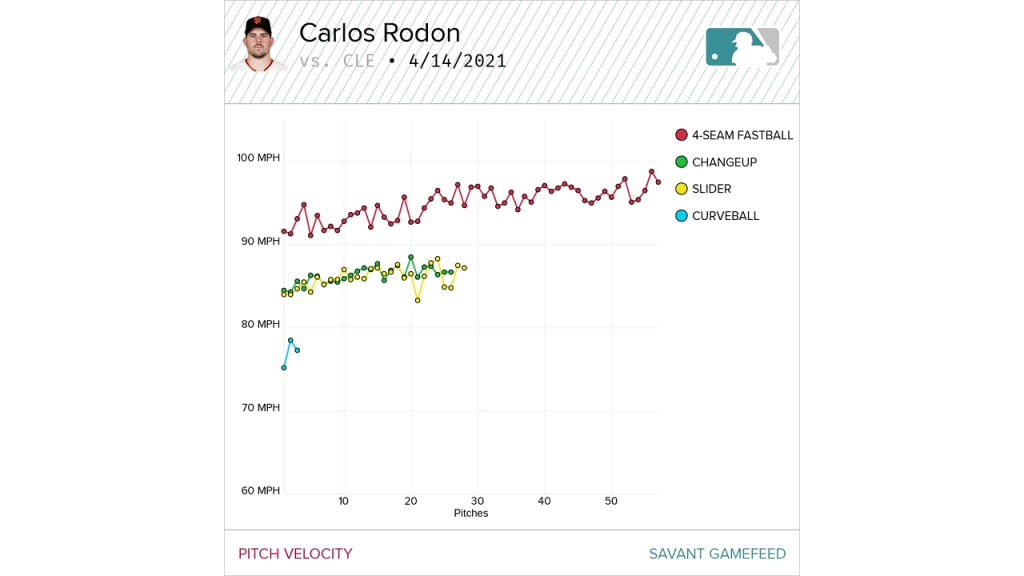
"That's more of a realistic way I pitch -- I kind of am (93 to 95) and then try to climb as I get deeper in the game and bring a harder fastball," Rodón said to NBC Sports earlier this year.
He does it all the time, too.
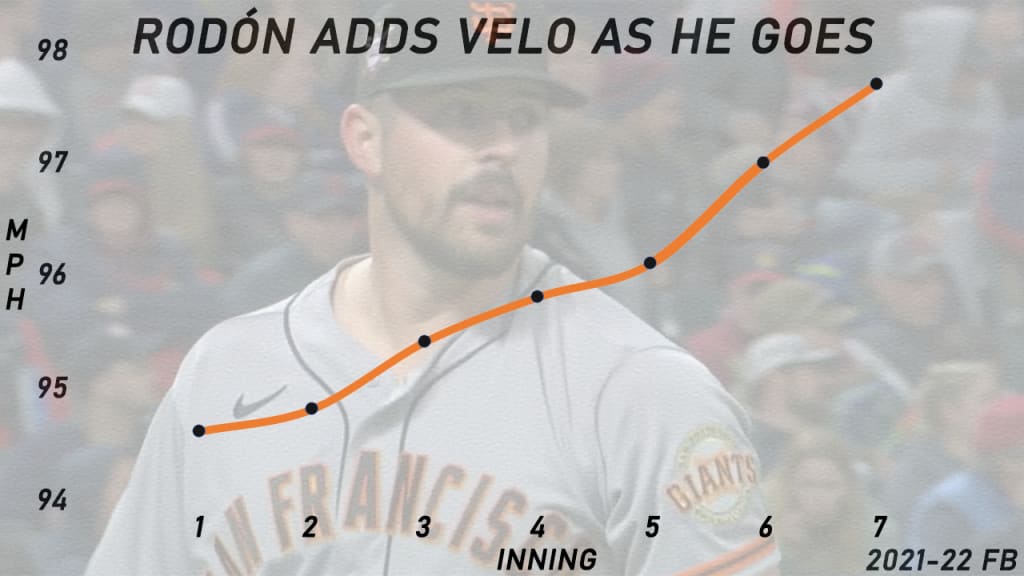
In a world where every pitcher seems to be going all-out on every single pitch, Rodón works in a more old-school way, apparently intentionally – and in a way just about no one else does. Looking at the last two seasons combined, Rodón’s first inning fastball velocity is 94.6 mph, but his seventh-inning fastball velocity is 97.7 mph, a jump of 3.1 mph.
Most starters who work that deep lose some velocity or stay consistent; only one other pitcher has added even two miles per hour from first to seventh over the last two seasons. That’s Rodón’s teammate Alex Wood, who is up 2.3 mph from the first to the seventh.
There's one more thing, though: The best pitch in baseball is not what he was originally known for. As a college pitcher, Rodón’s slider was his calling card. It’s still his best swing-and-miss pitch.
"[He’s got] two legit pitches,” Rockies manager Bud Black said to MLB Network Radio’s ‘Power Alley’ on Tuesday. “Fastball with life, carry, with velocity, and a really good breaking ball. You try to cover one of them for sure, and you’re looking for something, and you don’t get that pitch, it’s over. You’ve almost got to commit to one pitch and sit there and try to square it up, but it’s hard.”
But there’s something new this year, too. Rodón has turfed his changeup, the one that allowed a .612 slugging last year. Instead, his third pitch is a curveball. While he’s thrown it just 35 times, he’s yet to allow a hit on it. It’s a better pitch this year than last -- somehow, he’s throwing it harder and getting more drop, which is a neat trick -- and it's a perfect mirror of his four-seam. They work in concert.
“We’ve really pumped up what we think is a high-quality curveball,” said Martinez, the assistant pitching coach. “It was something he was kind of working on as a glove-strike option with Chicago, but he was still pretty changeup heavy. I think we’ve kind of emphasized to him that he can use that curveball as a changeup because it’s got a different movement profile from his slider and a little bit of a velo differential. Just the fact that he’s able to spin the ball really well, the fastball and the slider, we lean towards pumping up the curveball a little bit more than the changeup.”
“I think we’re witnessing something special,” Kapler, the manager, said. “It’s really an elite arm with elite carry.”
He's not wrong. In the last 18 months, the White Sox twice decided not to offer Rodón a contract. Now, in San Francisco, he's showing the White Sox what they're missing. He's showing the most dominating pitch in baseball.
MLB.com's Maria Guardado contributed to the reporting of this story.
